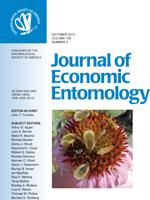The cotton fleahopper, Pseudatomoscelis seriatus (Reuter) (Hemiptera: Miridae) is an economically important insect pest of cotton in the United States. However, reports of cotton fleahopper infestation and its management in cotton fields are restricted primarily to Texas, Oklahoma, and Arkansas. The objective of this study was to understand the genetic diversity of cotton fleahopper populations infesting cotton in the cotton-growing areas of the United States. Amplified fragment length polymorphism markers were used to detect genetic diversity and to characterize geographic genotypes across the distribution of the cotton fleahopper in the United States. We used 172 individuals and 559 amplified fragment length polymorphism loci in this study and found significant, but low, level of genetic differentiation among geographic populations (FST = 0.02; P < 0.0001). Molecular fingerprints of cotton fleahopper populations were partitioned into three broad regional genetic populations with a western, central, and eastern distribution. The western (Arizona) and eastern (Florida, Georgia, South Carolina, and North Carolina) populations are genetically distinct, whereas the central (Texas, Oklahoma, Arkansas, Mississippi, Louisiana, and Alabama) population represents an admixed population, which include both western and eastern populations. These results suggest considerable gene flow among the populations within regions but restricted gene flow among populations from eastern and western region.
How to translate text using browser tools
1 October 2013
Population Genetic Structure of Pseudatomoscelis seriatus (Hemiptera: Miridae) in the Cotton-Growing Regions of the United States
Apurba K. Barman,
C. G. Sansone,
Megha N. Parajulee,
Raul F. Medina
ACCESS THE FULL ARTICLE
It is not available for individual sale.
This article is only available to subscribers.
It is not available for individual sale.
It is not available for individual sale.

Journal of Economic Entomology
Vol. 106 • No. 5
October 2013
Vol. 106 • No. 5
October 2013
AFLP
cotton pest
dispersal
gene flow
population structure




